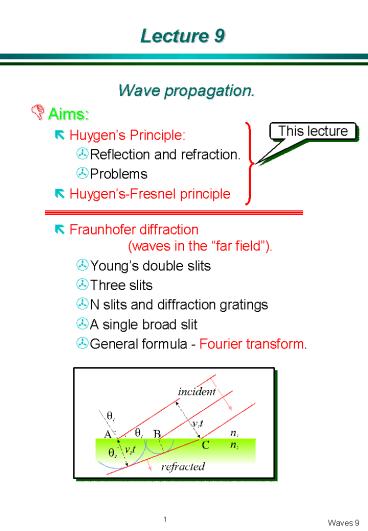Wave propagation. - PowerPoint PPT Presentation
1 / 4
Title:
Wave propagation.
Description:
Wave propagation. Aims: Huygen s Principle: Reflection and refraction. Problems Huygen s-Fresnel principle Fraunhofer diffraction (waves in the far field ). – PowerPoint PPT presentation
Number of Views:118
Avg rating:3.0/5.0
Title: Wave propagation.
1
Lecture 9
- Wave propagation.
- Aims
- Huygens Principle
- Reflection and refraction.
- Problems
- Huygens-Fresnel principle
- Fraunhofer diffraction (waves in the far
field). - Youngs double slits
- Three slits
- N slits and diffraction gratings
- A single broad slit
- General formula - Fourier transform.
This lecture
2
Huygens Principle
- Remember the concept of wavefront - a surface of
constant phase. - 1690 Treatise on light, Huygens.
- Every point of a primary wavefront behaves as
the source of spherical, secondary wavelets, such
that the primary wavefront at a later time is the
envelope of these wavelets the wavelets have the
same frequency and velocity as the incoming wave - Rectilinear propagation
- Spherical propagation
3
Reflection and refraction
- qr qi
- Result follows from the 2 right-angled triangles
with same hypotenuse, both having one side of
length vt. Thus qr qi. - Snells Law
4
Huygens-Fresnel principle
- Shortcomings It is easy to criticise Huygens
- No theoretical basis
- Why neglect parts of the wavelet other than those
forming the envelope - Why dont wavelets propogate backwards
- It is no help in predicting amplitudes etc...
- None detract from its historical significnce and
the fact that it works. - Fresnel (1818) (See handout).
- He built in Youngs concept of interference.
Every unobstructed point of a wavefront serves
as a source of spherical secondary wavelets The
amplitude of the optical field at any point
beyond is the superposition of all these wavelets
(considering their amplitudes and relative
phases) - Note backward travelling wavelets tend to
interfere destructively - Kirchoff (1824-1887)
- Provided theoretical foundation by connecting the
wave equation to a surface integral of spherical
wavelets. - See Optics course, next term.































